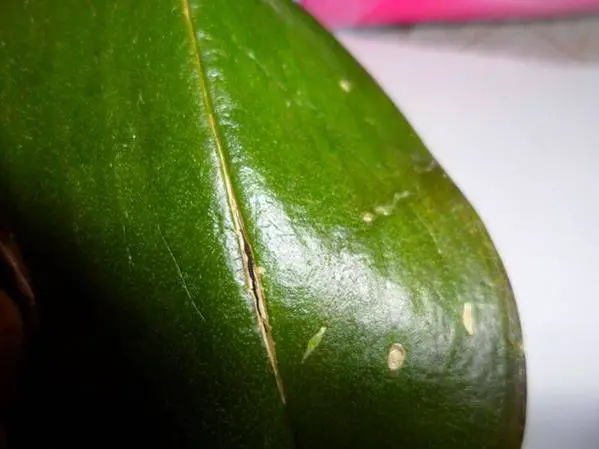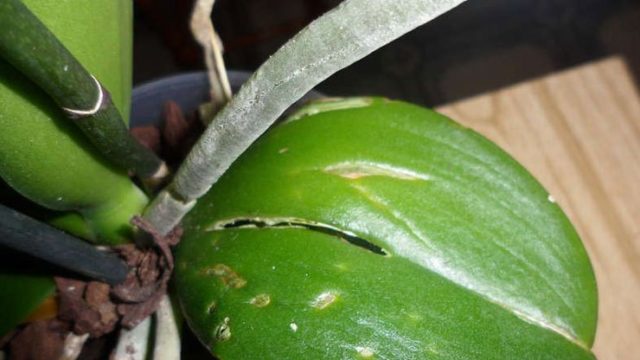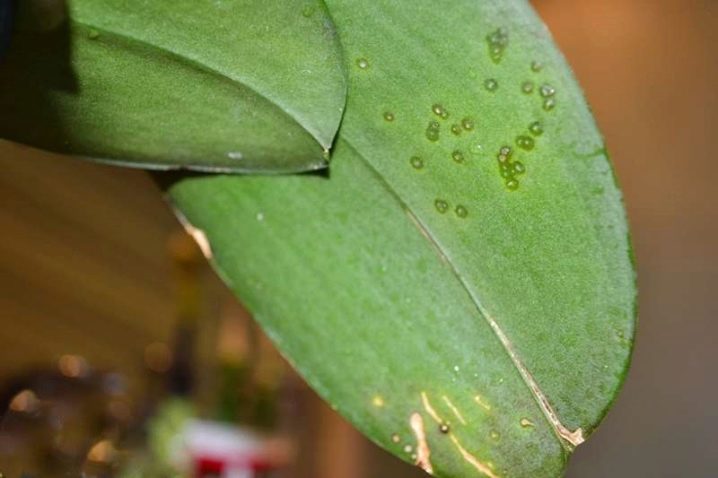Phalaenopsis is the oldest family that arose in the late Cretaceous era. Spitting orchid leaves at home is the main problem faced by many beginners. It may split from the middle, tips or down, etc.
Here we are discussing orchid leaves splitting down the middle and what are reasons for it and how to solve the problem.
The habitat of orchids is tropical and subtropical latitudes, areas with a short season without rains and high humidity, and an abundance of precipitation, which creates the most suitable conditions for their growth.

why do orchid leaves splitting down the middle?
When keeping orchids at home, care rules may not be followed :
- watering,
- lighting,
- The humidity of the room where the flower is located,
- The amount of fertilizer applied may not meet the needs of the plant,
- Incorrectly selected substrate.
All these factors can lead to the orchid leaves splitting down the middle, the tip of the leaf plate may burst in plants, or a crack appears in the middle along the main vein of the leaf, and the lower leaves of orchids most often burst.
At the same time, the leaf does not rot, does not fall off, and does not turn yellow, but the general appearance of the flower is disappointing.

Appearance is a direct consequence of the internal state of the plant, therefore, it is necessary to find out the causes of leaf cracks, since metabolism is disturbed and the plant may die. Read if you are facing Sunburn On Orchid Leaves.
orchid leaves splitting down the middle due to the wrong movement
When moving, transporting a flower from a store home, transplanting pets, and possibly small children, microtrauma can be caused, which later develops into a crack.
Usually, such damage is covered with mechanical tissue and does not cause much harm to the orchid. If the leaf is split into two halves, then the wound should be treated with an antiseptic solution to prevent decay processes and disinfect the damaged area.
Weak root system
Sometimes during transplantation or as a result of damage to the root system by fungal diseases, some of the roots are injured and die.
Therefore, the flower cannot provide its large leaves with enough nutrients, and the leaf plate cracks. To solve this problem, you need to cut off part of the leaves.
To do this, a part of the leaf plate is cut off with disinfected tools, the cut point, which is an open wound, is treated with powdered activated carbon, watered every 7-10 days and the plant rests to restore the green mass and root system.
A weak root system of the plant can lead to cracks.
irregular watering
Overdrying and insufficient watering every two to three weeks can lead to flower dehydration, especially in summer at elevated temperatures and bright light. here is the solution to Orchid Stem Dried Out.
After all, orchids are tropical flowers, the evaporation rate of which, when the air is dry and the temperature is above 30 degrees, is ten times faster than usual.
Advice! To prevent this situation, you must turn on the humidifier or spray the plant with warm water.
Proper watering is very important for the health of orchid leaves.
Orchid Placement
Orchids are native to tropical forests, but direct sunlight can have a detrimental effect on them. If the orchid stands on the south window, then in addition to burns, drying of the leaves may occur, the leaf plate is divided at the place where the main vein passes.
In this case, the plant should be removed in a shaded place, away from bright sunlight, provide diffused light, and increase the humidity of the room.
The orchid loves diffused light.
Use of Excess nitrogen fertilizers
This reason is highly unlikely, and now you will find out why. When nitrogen fertilizers are applied, the phalaenopsis grows green mass, the leaf plates thicken, their color becomes dark green, and their deformation may occur – the leaves become wavy at the edges.
Peduncles are absent or one or two buds appear, which quickly fade. And only after that comes the cracking of the sheet plate. But for this to happen, you just need to apply a huge amount of fertilizer containing nitrogen.
To solve this problem, you need to remove the plant from the pot, wash the root system in warm water, and transplant it into a new soil mixture. In the future, it is necessary to ensure peace for the plant, and later, after 2-3 months, it is worth applying potash fertilizers once a month.
Orchid Cold Damage
This situation is more common in cold timewhen, after watering or spraying, the flower is placed on the windowsill or the room is ventilated.
Moisture stagnation in the pot is also possible, and if the temperature in the room is below 16 degrees, then the absorption of cold water by the aerial part of the plant leads to cracking in the middle or cracking at the tip of the leaf if it comes into contact with cold glass.
Hypothermia leads to the destruction of vessels passing through the middle of the leaf to the roots, which can provoke the development of rot.
TIP! To prevent this, it is necessary to water the plant only with warm water, monitor the temperature regime near the window – not lower than 18-24 degrees, exclude cold air near the orchids, wipe the leaves after watering.
Overcooling can lead to the death of the roots.
Many people often face the problem of Orchid Leaves Turn Yellow And Fall Off.
Temperature changes
Although orchids require temperature differences for the appearance of flowers, they should be in the range of +/- 5 degrees.
If the temperature difference between day and night is more than 5 degrees, the leaf tissue will be weakened, which will cause cracks and damage. The flower can drop all the leaves and be in an oppressed stage. It is necessary to exclude temperature fluctuations or minimize them.
Treatment of orchid leaves splitting down the middle
Succinic acid is a very strong antioxidant that restores the green mass of the plant. It can be bought at the pharmacy in the form of tablets, or powder, and diluted in warm water.
In case of damage, they process the sheet plate and make sure that water does not get into the sinuses.
Succinic acid is an assistant to the grower.
How do you keep orchid leaves from splitting?

For the growth and flowering of orchids, you should follow the simple rules for proper care of these plants:
- Maintain the temperature in the room in winter 18-24, and in summer 25 degrees.
- Observe humidity 50-60%.
- Fertilize orchids with potash and phosphorus fertilizers 1-2 times a month.
- Place the flower on the sunny side, but provide some shade.
Conclusion
First figure out the reason for orchid leaves splitting down the middle from the above-mentioned reason then take care of your beautiful plant. Proper care is the only way to save plants from any damage.
